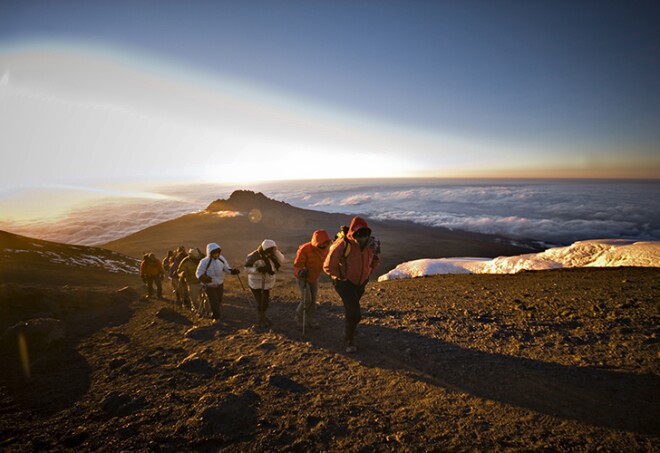Mount Kilimanjaro is a treasure of Tanzania and a popular attraction for tourists wanting to conquer Africa’s tallest mountain. Because of its fame and relatively easy ascent—if you don’t count the altitude sickness—this hike attracts more than 16,000 climbers a year. If you want to climb in relative peace, take the Northern Circuit detour, which avoids the busiest trails.
More Recommendations
Mount Kilimanjaro
One of my first travel ‘goals’ was to summit Kilimanjaro. It was also one of those “way out there” goals that I didn’t think I would accomplish - until I happened upon a group that offered the trip at a time and price that worked for me. From Abu Dhabi, I hopped on a plane to Nairobi, crossed the border to Arusha, Tanzania and promptly sought to conquer the mountain.
Five days was a bit too short for acclimatization (and I battled with altitude our entire summit day), but the even the short ascent could not diminish the experience of trekking up through various climate zones to summit Uhuru Peak: cultivation, rainforest, heather or low alpine), high alpine desert, and glacial zones.
Taking a Break
A photo of our trekking group on an acclimatization trek up the flanks of Mawenzi. Our assistant guide Musa is on the left. Sitting is a collection of Englishmen, an Irish honeymooner couple, a group of Swiss friends. The Swiss spoke mostly French so, of course, it fell to us Canadians to be the translators. English had a hell of a time with the altitude, but the Swiss seemed dauntless and did the entire trek on a diet of muesli and dark chocolate.
Roof of Africa
Climbing to the summit of Mt Kilimanjaro in Tanzania was a highlight of my life. In honor of my dad’s 60th birthday, my family and I hiked up the Machame Route to Uhuru peak (19,341 ft). This is the highest point in Africa, nicknamed the Roof of Africa. Our route took us from Moshi, where the mountain looms large over the city below and where you can explore the local markets, up & down Kili in 10 days. Listening to the stories and songs of our guides and porters was as much a highlight as the stunning vistas in every direction. On the 2nd night we slept near Shira Plateau (12,480 ft). This was the view from my tent, and the structure pictured above is an outhouse. At each camp I was struck by the juxtaposition of these buildings of necessity perched precariously on the edge of awesome natural scenery. Something about the fresh air, sunrise glowing off the distant peaks, and striking color of the outhouse roof made me stop to capture the moment. I couldn’t take my eyes off the outhouses! This trek isn’t for everyone, and that’s why it is so special. We went with Tusker Trails because of their safety record, gear standards, and that they helped organize the union for porters on Kili. There are lots of operators, but we were thrilled with our experience (3 hot meals/day and hot water to clean up with at the end of each dusty day!). To arrive, you fly into Arusha Intl airport. Truly a trip of a lifetime in a country of natural beauty.
View from the top!
I took this photo with frozen hands but am glad I did as it’s a great view of the path of descent from the top of Kilimanjaro (which is right behind me in this photo). Every step down the mountain was another step closer to more oxygen! We were all fairly giddy with the oxygen when we got back to 12,000 feet (where we stopped for the night). If you’re thinking of climbing Kili, definitely consider REI. The trip I did also included a follow-up safari - also highly recommended. REI: Mount Kilimanjaro Climb - Marangu Route and Safari Extension
Kilimanjaro Climb
The Machame Route is one of the best options for climbing Kilimanjaro and is reputed to have the highest success rate. The route offers a longer period for acclimatization than the popular Marangu approach and has the added advantage that it incorporates different routes up and down the mountain so there is no backtracking. The first day of trekking is about 5 hours through dense rainforest. The second day continues through increasingly sparse trees and bushes into the moorlands. The third day is quite helpful for acclimatization as you ascend to the Lava Tower (15,000 feet / 4600m) before descending to the campsite. The area before the campsite is known as the “Garden of the Senecios”, which features many huge Senecio plants as well as the shorter Lobelia plants. The fourth day starts with the ascent of the Barranco Wall the most difficult part of the climb outside of the actual summit ascent. The high camp at Barafu sits on a barren volcanic plain and you can spend the afternoon resting here before the final push to the summit. The climb begins at midnight and takes about 6 hours with most climbers reaching the crater rim just as the sun begins to rise. Going back down the trek takes you to Mweka Gate where transport will be waiting to take you back to Moshi to enjoy a final farewell dinner.











